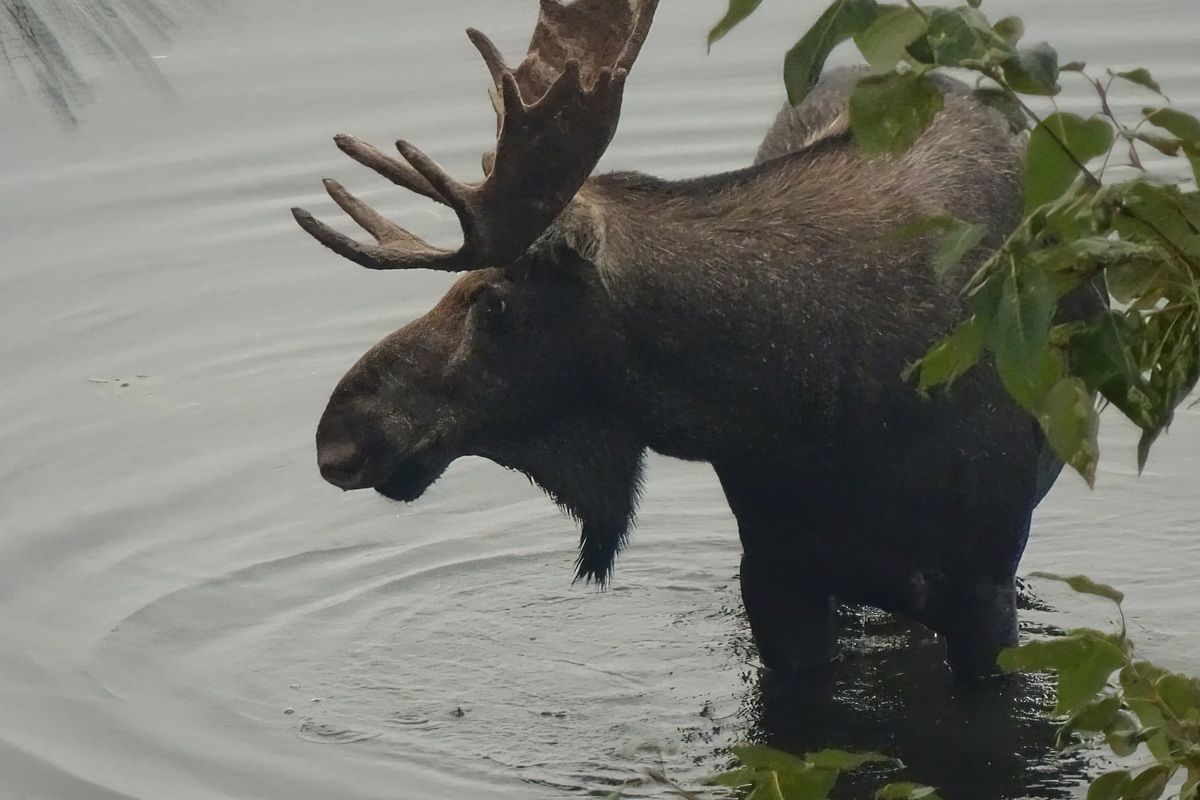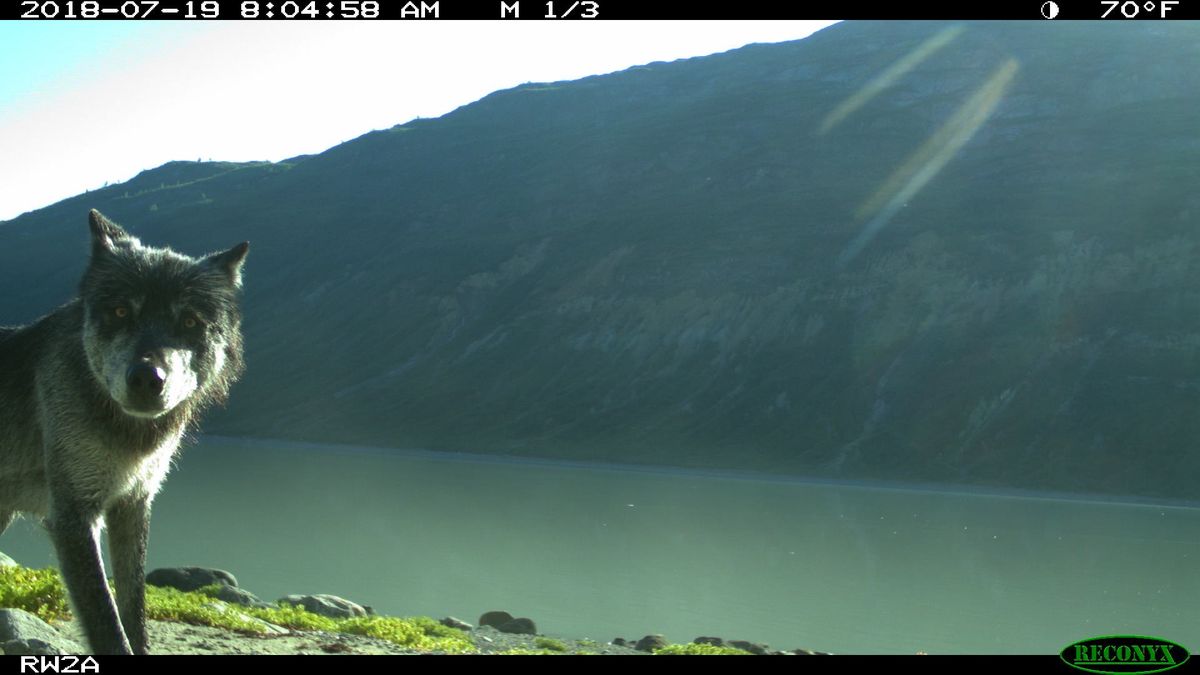UW study finds wild animals are more sensitive to human presence than previously thought, raising questions about local trail management
A study published this month found that wild animals, including moose like this bull spotted on Hauser Lake, are even more sensitive to human presence than previously thought. (Angela Marie/Courtesy)
We have a people problem.
That was the message Laura Prugh received from the U.S. Park Service in Glacier Bay, Alaska, several years ago. For Prugh, who studies human-wildlife interactions in the relatively crowded state of Washington, the claim seemed a bit overstated. After all, only 40,000 people visit the 3.2-million-acre park annually – absurdly low numbers for anyone accustomed to recreating in the Washington or Oregon Cascades, for instance.
In fact, Glacier Bay is only accessed by boat or plane and 94% of visitors come via cruise ship. Yet, park service employees reported increasing numbers and they wanted to know how – or if – that trend was impacting native wildlife. So Prugh, an associate professor in the University of Washington School of Environmental and Forest Sciences, visited.
“I was just shocked at how few people there were,” she said. “And I thought ‘Wow, these people have really lost perspective on what a lot of visitors are.’ ”
Still, she agreed to conduct the study. Over the course of two summers, she collected images from 40 motion-activated cameras across 10 sites focusing on wolves, black bears, brown bears and moose. She fully expected to find little to no “difference in animal activity between the high-use sites and the low-use sites.”
She was wrong.
In a study published this month, Prugh and her co-authors found if humans were present, the cameras detected fewer than five animals per week across all four species studied. In most cases, this likely meant that animals avoided areas where humans were present. Second, in backcountry areas, wildlife detections dropped to zero each week once outdoor recreation levels reached the equivalent of about 40 visitors per week. The researchers note that in some places where animals are more habituated to humans the reaction to human presence will be less.
While it’s just one study, in one place, the findings have implications for recreation management , including in Washington.
“Our study indicates that if people want to recreate and minimize their impact on wildlife, it would actually be better to go hiking on busier trails because those sites are disturbing wildlife anyway,” she said. “I think, unfortunately, there is a trade-off with the human’s experience and the impact on wildlife.”
A developing field
The question of how, or even if, outdoor human recreation of the nonhunting variety impacts wildlife is “kind of an emerging field,” Prugh said. Despite its relative youth, numerous recreation ecology studies have shown that animals do change their behavior in response to humans presence. Some mammals have become more nocturnal, forgoing their normal daytime routines in hopes of avoiding human presence. In Montana, wolverines and bighorn sheep avoid areas where backcountry skiers shred. Wild reindeer flee farther and longer from backcountry skiers than from snowmobiles, according to another study.
That’s all well documented; however, what hadn’t been looked at was the minimum threshold of disturbance or, in simpler terms, just how many humans does it take to send a grizzly packing, said Joel Berger, a professor at Colorado State University and the author of “The Better to Eat You With: Fear in the Animal World.”
The UW study begins to answer that question, he said. Berger was not part of Prugh’s study and hasn’t met her, although he said he’s admired her research .
“The Prugh study provides the first quantitative evidence, in my impression, on responses of species of wildlife when exposed to people in these low-density situations,” he said.
He said it also showed variation in species response to human activity, noting that Prugh’s study found that moose were more active if people were around, indicating the large ungulates were using human presence as a shield against warier animals, like wolves. That’s known as the human-shield hypothesis, a term coined by Berger.
“The question is, what does it take for animals to learn?” he said. “To be able to adopt this anti-predator anti-harassment disturbance strategy.”
In addition to those questions the study also raises a conundrum for recreation planners and outdoor enthusiasts, both in remote and more urban settings.
Implications for recreation
The balance between recreation and wildlife is something Paul Knowles, Spokane County’s park planner, considers often.
“As a land manager you sacrifice some areas, in a sense, so that others can be primarily dedicated to wildlife habitat,” he said.
When county planners design and build trails they try to include “wildlife disturbance buffers.” These buffers are built using the best available science on how much space species need from humans. In an urbanized environment like Spokane County, however, it’s not always possible to include that space.
Anecdotally, at least, Knowles said he’s heard “time and time again” that once a property is acquired by the county and developed for recreation, wildlife sightings plummet.
“We acquire these conservation areas for multiple purposes and multiple benefits, including recreation,” he said. “So we have to find a way to balance those out. It’s tough.”
That’s the larger point, Prugh said. She has no desire or intention to tell people they shouldn’t hike. But recreationists should be aware that their activity – no matter how peaceful seeming – affects wildlife.
“It’s not that people should stop recreation,” she said. “But what is the best way to balance these trade-offs?”

